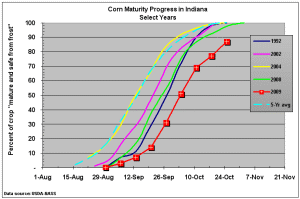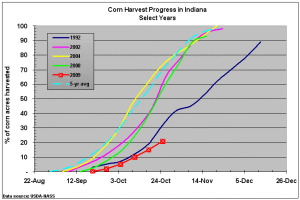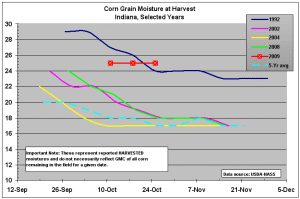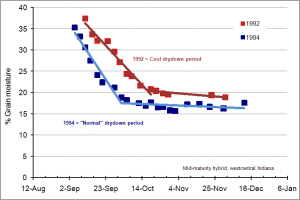27 Oct 2009
URL: http://www.kingcorn.org/news/articles.09/CropProgress-1027.html
Corn Crop Continues Snail's Pace of Grain Drying & Harvest
R.L. (Bob) Nielsen
Agronomy Dept., Purdue Univ.
West Lafayette, IN 47907-2054
Email address: rnielsen
at purdue.edu

Fig 1. Progress of the 2009 Indiana corn crop in reaching
physiological maturity (source: USDA-NASS, as of 10/25).

Fig. 2. Harvest progress of the 2009 Indiana corn crop
(source: USDA-NASS, as of 10/25).

Fig. 3. Reported grain moisture content at harvest for
the 2009 Indiana corn crop (source: USDA-NASS, as of
10/25).

Fig. 4. Example of field drying progress of a mid-maturity
corn hybrid in 2 years with different temperature patterns.
![]() onday's report from the USDA National Agricultural Statistics Service (USDA-NASS, 2009) reaffirms that the 2009 Indiana corn crop is continuing its near-record slow pace of development, maturity, and harvest. As of 25 October, 87% of the state's corn crop had reached maturity (Fig. 1) and 21% of the crop was reported as having been harvested (Fig. 2). These numbers represent progress that is 3 to 4 weeks behind the five-year pace for maturity and harvest.
onday's report from the USDA National Agricultural Statistics Service (USDA-NASS, 2009) reaffirms that the 2009 Indiana corn crop is continuing its near-record slow pace of development, maturity, and harvest. As of 25 October, 87% of the state's corn crop had reached maturity (Fig. 1) and 21% of the crop was reported as having been harvested (Fig. 2). These numbers represent progress that is 3 to 4 weeks behind the five-year pace for maturity and harvest.
Indiana farmers have held off harvest of corn because they have concentrated on harvesting the similarly delayed soybean crop and because corn grain moisture has been literally too wet to harvest without incurring mechanical grain damage or wetter than desirable in terms of the expense of grain drying or price dockage at the elevators. Further delays in harvest of both crops have resulted from the frequent periods of rain throughout the state.
Throughout much of the growing season, the 2009 crop was tracking similarly to the cool 1992 crop (Nielsen, 2009a; Nielsen, 2009b), but has since fallen behind even that very slow crop year (Fig's 1 & 2). Recent weeks with rainy weather and cool temperatures have simply put the brakes on the drying progress of the grain in standing corn fields around the state. Reported grain moistures at harvest have held steady at 25% grain moisture content for the past three weeks (Fig. 3); in line with those reported in 1992 but much higher than we typically experience in mid- to late October.
Even at this late date, some folks seem to be waiting for a miraculous arrival of "Indian summer" to hasten the in-field drying of corn grain so that they can harvest at moistures of 20% or less. Meanwhile, stalk health and grain quality continue to deteriorate due to the processes of weathering and disease.
Recognize that grain moisture content typically decreases very, very slowly from late October onward. By late October, one can usually not expect much more than 1/4 to 1/2 percentage point decrease per day with NORMAL temperatures.
The AVERAGE daily temperature statewide for Indiana in October is 53.6F, then drops to average daily temperatures of only 42.3F during November (Indiana State Climate Office, 2009). These climatic data explain why the rate of grain moisture loss in the field "drops off like a rock" during October and basically "flat lines" through November (Fig. 4). Factor in this October's cooler than normal temperatures and it is no surprise why grain moisture has not changed very significantly in recent weeks.
The bottom line is that we should not expect much more significant grain drying in the field from this point forward unless that miraculous "Indian summer" arrives in the very near future.
Related References
Indiana State Climate Office. 2009. [online] http://climate.agry.purdue.edu/climate/facts.asp. [URL accessed Oct 2009].
Nielsen, R.L. (Bob). 2009a. A Tale of Three Cropping Seasons. Corny News Network, Purdue Univ. [online]. http://www.kingcorn.org/news/articles.09/CropProgress-0803.html. [URL accessed Oct 2009].
Nielsen, R.L. (Bob). 2009b. Cool Days, Cold Nights, Slow Corn, What's Next? Corny News Network, Purdue Univ. [online]. http://www.kingcorn.org/news/articles.09/CropProgress-0901.html. [URL accessed Oct 2009].
Nielsen, R.L. (Bob). 2009c. Field Drydown of Mature Corn Grain. Corny News Network, Purdue Univ. [online]. http://www.kingcorn.org/news/timeless/GrainDrying.html. [URL accessed Oct 2009].
Nielsen, R.L. (Bob). 2009d. Stress During Grain Fill: A Harbinger of Stalk Health Problems. Corny News Network, Purdue Univ. [online]. http://www.kingcorn.org/news/timeless/StalkHealth.html. [URL accessed Oct 2009].
USDA-NASS. 2009. Crop Progress. USDA National Agricultural Statistics Service. [online] http://usda.mannlib.cornell.edu/usda/current/CropProg/CropProg-10-26-2009.pdf. [URL accessed Oct 2009].

